Effectiveness of Loyalty Programs and Reward Schemes
VerifiedAdded on 2020/07/23
|11
|3451
|482
AI Summary
The report focuses on the research methodology used to analyze the effectiveness of loyalty programs and reward schemes in retaining customers. It highlights the importance of standard and quality products and services, as well as schemes like loyalty and reward providing, which make customers find it attractive enough to shop their products and get benefits in return. The document provides a comprehensive analysis of various studies on loyalty program research, including their adoption, effectiveness, and design.
Contribute Materials
Your contribution can guide someone’s learning journey. Share your
documents today.

Research Project
Secure Best Marks with AI Grader
Need help grading? Try our AI Grader for instant feedback on your assignments.
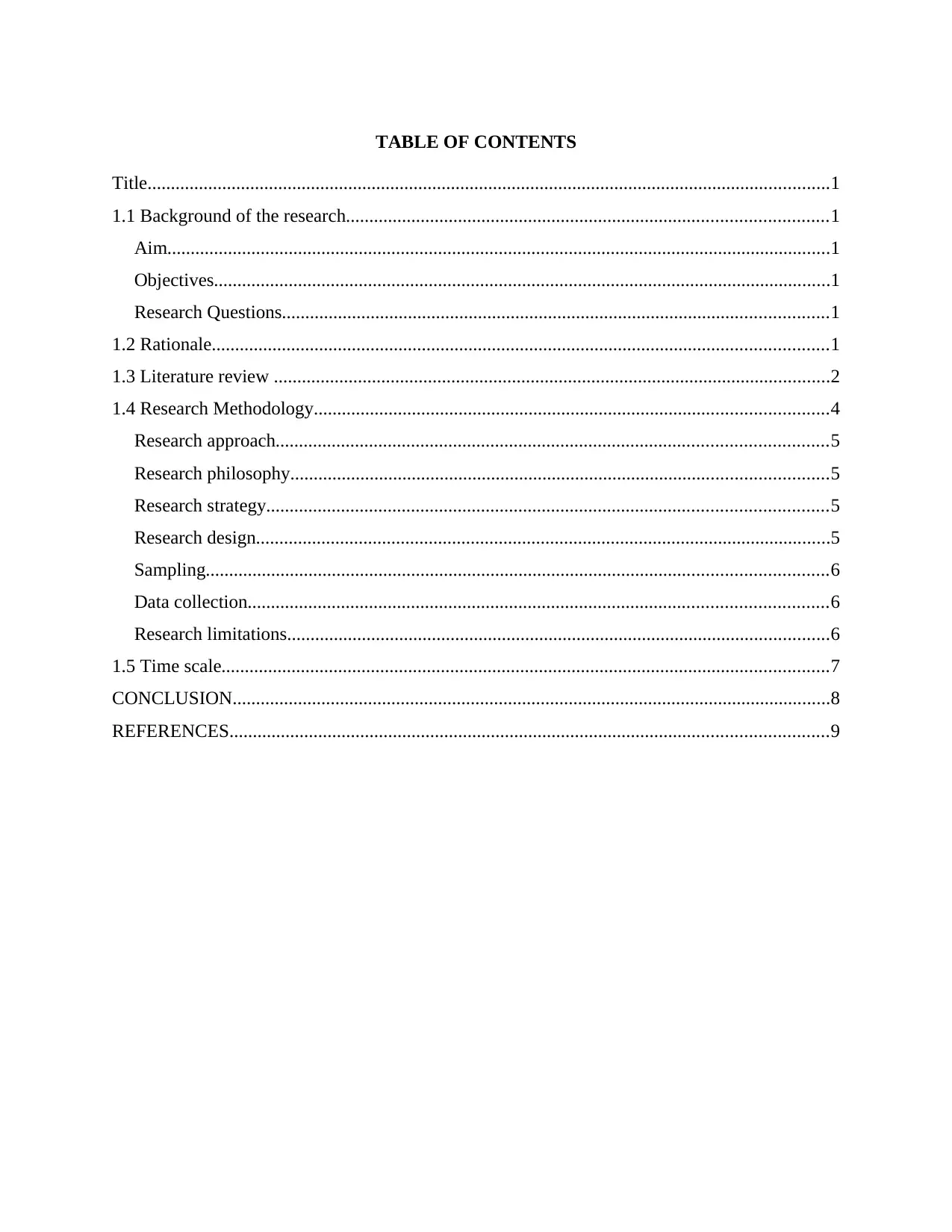
TABLE OF CONTENTS
Title..................................................................................................................................................1
1.1 Background of the research.......................................................................................................1
Aim..............................................................................................................................................1
Objectives....................................................................................................................................1
Research Questions.....................................................................................................................1
1.2 Rationale....................................................................................................................................1
1.3 Literature review .......................................................................................................................2
1.4 Research Methodology..............................................................................................................4
Research approach......................................................................................................................5
Research philosophy...................................................................................................................5
Research strategy........................................................................................................................5
Research design...........................................................................................................................5
Sampling.....................................................................................................................................6
Data collection............................................................................................................................6
Research limitations....................................................................................................................6
1.5 Time scale..................................................................................................................................7
CONCLUSION................................................................................................................................8
REFERENCES................................................................................................................................9
Title..................................................................................................................................................1
1.1 Background of the research.......................................................................................................1
Aim..............................................................................................................................................1
Objectives....................................................................................................................................1
Research Questions.....................................................................................................................1
1.2 Rationale....................................................................................................................................1
1.3 Literature review .......................................................................................................................2
1.4 Research Methodology..............................................................................................................4
Research approach......................................................................................................................5
Research philosophy...................................................................................................................5
Research strategy........................................................................................................................5
Research design...........................................................................................................................5
Sampling.....................................................................................................................................6
Data collection............................................................................................................................6
Research limitations....................................................................................................................6
1.5 Time scale..................................................................................................................................7
CONCLUSION................................................................................................................................8
REFERENCES................................................................................................................................9
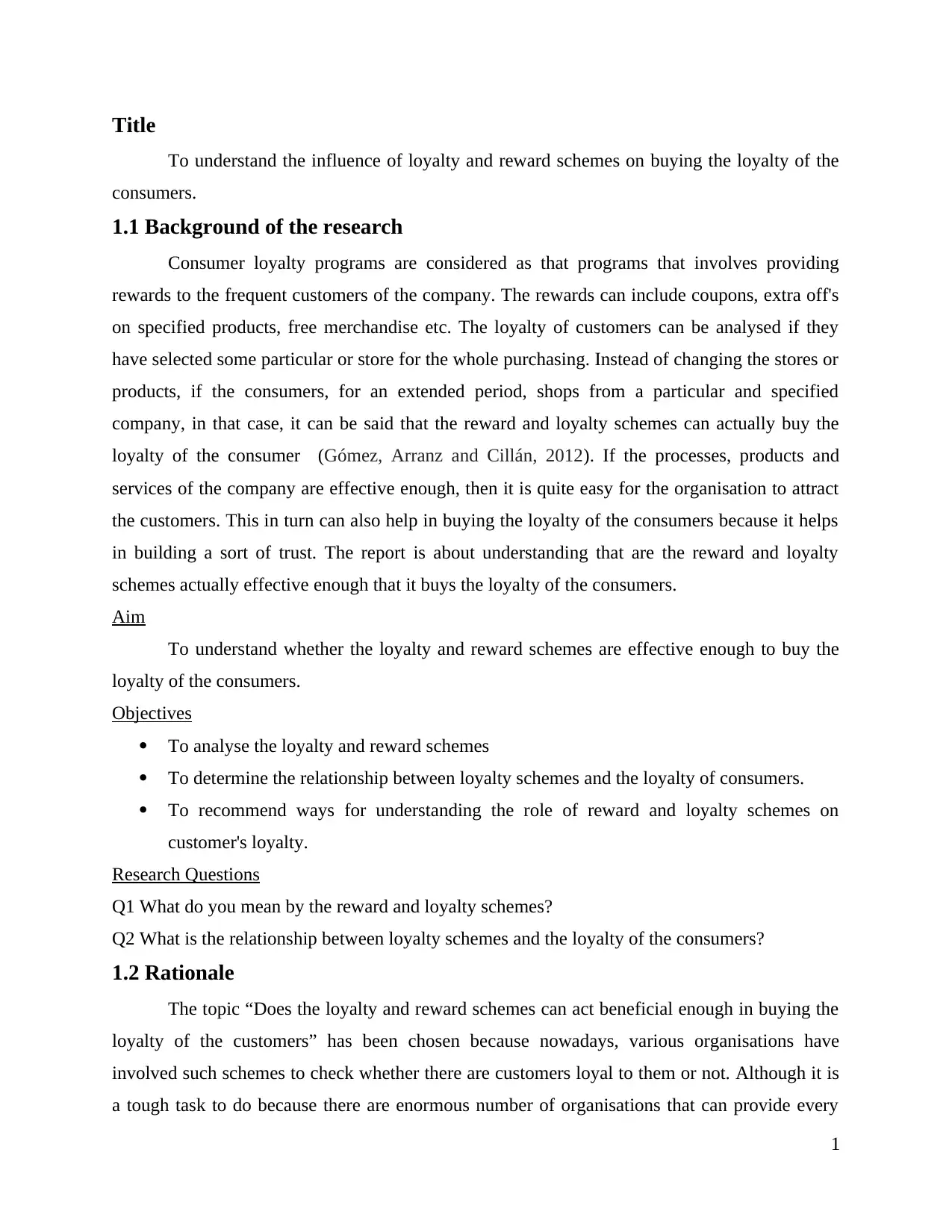
Title
To understand the influence of loyalty and reward schemes on buying the loyalty of the
consumers.
1.1 Background of the research
Consumer loyalty programs are considered as that programs that involves providing
rewards to the frequent customers of the company. The rewards can include coupons, extra off's
on specified products, free merchandise etc. The loyalty of customers can be analysed if they
have selected some particular or store for the whole purchasing. Instead of changing the stores or
products, if the consumers, for an extended period, shops from a particular and specified
company, in that case, it can be said that the reward and loyalty schemes can actually buy the
loyalty of the consumer (Gómez, Arranz and Cillán, 2012). If the processes, products and
services of the company are effective enough, then it is quite easy for the organisation to attract
the customers. This in turn can also help in buying the loyalty of the consumers because it helps
in building a sort of trust. The report is about understanding that are the reward and loyalty
schemes actually effective enough that it buys the loyalty of the consumers.
Aim
To understand whether the loyalty and reward schemes are effective enough to buy the
loyalty of the consumers.
Objectives
To analyse the loyalty and reward schemes
To determine the relationship between loyalty schemes and the loyalty of consumers.
To recommend ways for understanding the role of reward and loyalty schemes on
customer's loyalty.
Research Questions
Q1 What do you mean by the reward and loyalty schemes?
Q2 What is the relationship between loyalty schemes and the loyalty of the consumers?
1.2 Rationale
The topic “Does the loyalty and reward schemes can act beneficial enough in buying the
loyalty of the customers” has been chosen because nowadays, various organisations have
involved such schemes to check whether there are customers loyal to them or not. Although it is
a tough task to do because there are enormous number of organisations that can provide every
1
To understand the influence of loyalty and reward schemes on buying the loyalty of the
consumers.
1.1 Background of the research
Consumer loyalty programs are considered as that programs that involves providing
rewards to the frequent customers of the company. The rewards can include coupons, extra off's
on specified products, free merchandise etc. The loyalty of customers can be analysed if they
have selected some particular or store for the whole purchasing. Instead of changing the stores or
products, if the consumers, for an extended period, shops from a particular and specified
company, in that case, it can be said that the reward and loyalty schemes can actually buy the
loyalty of the consumer (Gómez, Arranz and Cillán, 2012). If the processes, products and
services of the company are effective enough, then it is quite easy for the organisation to attract
the customers. This in turn can also help in buying the loyalty of the consumers because it helps
in building a sort of trust. The report is about understanding that are the reward and loyalty
schemes actually effective enough that it buys the loyalty of the consumers.
Aim
To understand whether the loyalty and reward schemes are effective enough to buy the
loyalty of the consumers.
Objectives
To analyse the loyalty and reward schemes
To determine the relationship between loyalty schemes and the loyalty of consumers.
To recommend ways for understanding the role of reward and loyalty schemes on
customer's loyalty.
Research Questions
Q1 What do you mean by the reward and loyalty schemes?
Q2 What is the relationship between loyalty schemes and the loyalty of the consumers?
1.2 Rationale
The topic “Does the loyalty and reward schemes can act beneficial enough in buying the
loyalty of the customers” has been chosen because nowadays, various organisations have
involved such schemes to check whether there are customers loyal to them or not. Although it is
a tough task to do because there are enormous number of organisations that can provide every
1
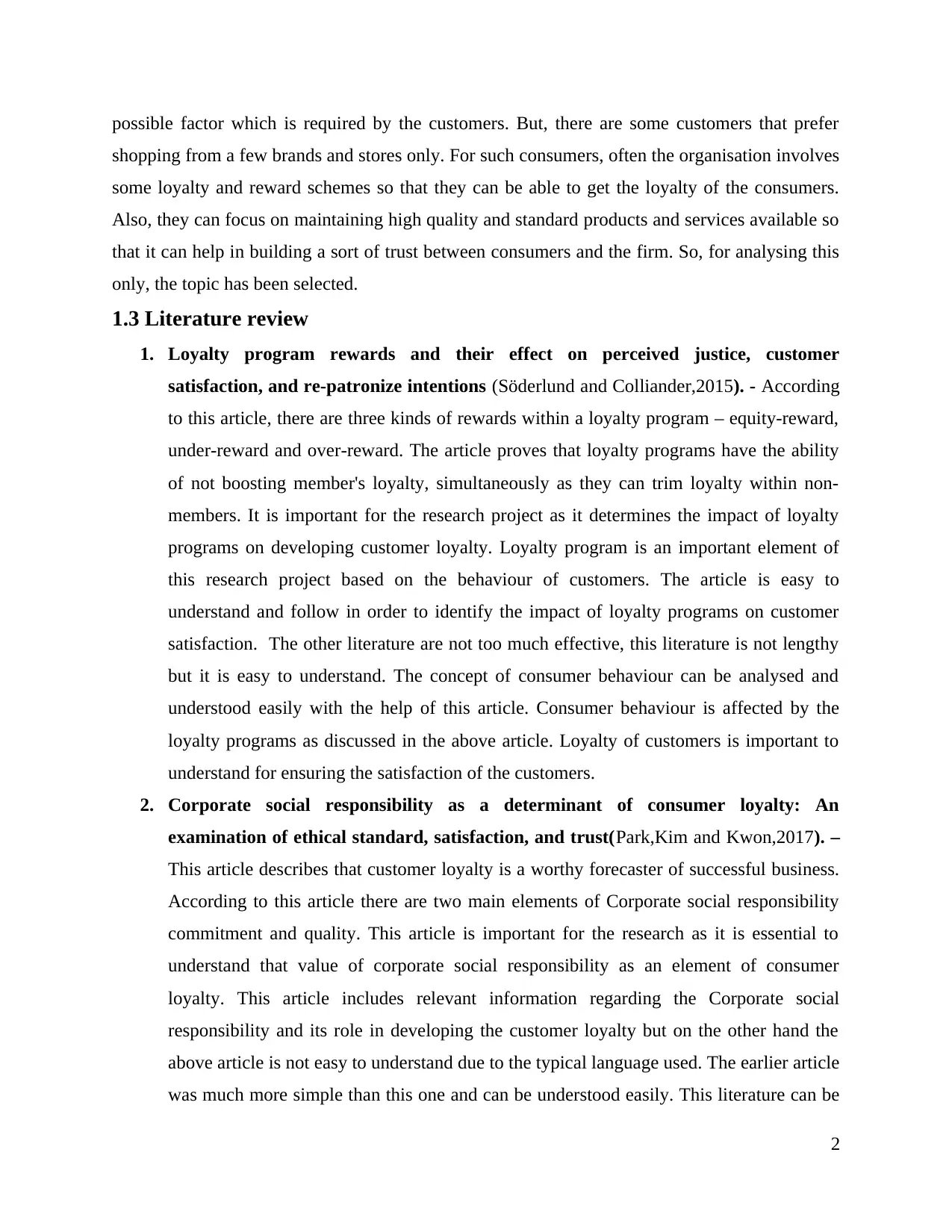
possible factor which is required by the customers. But, there are some customers that prefer
shopping from a few brands and stores only. For such consumers, often the organisation involves
some loyalty and reward schemes so that they can be able to get the loyalty of the consumers.
Also, they can focus on maintaining high quality and standard products and services available so
that it can help in building a sort of trust between consumers and the firm. So, for analysing this
only, the topic has been selected.
1.3 Literature review
1. Loyalty program rewards and their effect on perceived justice, customer
satisfaction, and re-patronize intentions (Söderlund and Colliander,2015). - According
to this article, there are three kinds of rewards within a loyalty program – equity-reward,
under-reward and over-reward. The article proves that loyalty programs have the ability
of not boosting member's loyalty, simultaneously as they can trim loyalty within non-
members. It is important for the research project as it determines the impact of loyalty
programs on developing customer loyalty. Loyalty program is an important element of
this research project based on the behaviour of customers. The article is easy to
understand and follow in order to identify the impact of loyalty programs on customer
satisfaction. The other literature are not too much effective, this literature is not lengthy
but it is easy to understand. The concept of consumer behaviour can be analysed and
understood easily with the help of this article. Consumer behaviour is affected by the
loyalty programs as discussed in the above article. Loyalty of customers is important to
understand for ensuring the satisfaction of the customers.
2. Corporate social responsibility as a determinant of consumer loyalty: An
examination of ethical standard, satisfaction, and trust(Park,Kim and Kwon,2017). –
This article describes that customer loyalty is a worthy forecaster of successful business.
According to this article there are two main elements of Corporate social responsibility
commitment and quality. This article is important for the research as it is essential to
understand that value of corporate social responsibility as an element of consumer
loyalty. This article includes relevant information regarding the Corporate social
responsibility and its role in developing the customer loyalty but on the other hand the
above article is not easy to understand due to the typical language used. The earlier article
was much more simple than this one and can be understood easily. This literature can be
2
shopping from a few brands and stores only. For such consumers, often the organisation involves
some loyalty and reward schemes so that they can be able to get the loyalty of the consumers.
Also, they can focus on maintaining high quality and standard products and services available so
that it can help in building a sort of trust between consumers and the firm. So, for analysing this
only, the topic has been selected.
1.3 Literature review
1. Loyalty program rewards and their effect on perceived justice, customer
satisfaction, and re-patronize intentions (Söderlund and Colliander,2015). - According
to this article, there are three kinds of rewards within a loyalty program – equity-reward,
under-reward and over-reward. The article proves that loyalty programs have the ability
of not boosting member's loyalty, simultaneously as they can trim loyalty within non-
members. It is important for the research project as it determines the impact of loyalty
programs on developing customer loyalty. Loyalty program is an important element of
this research project based on the behaviour of customers. The article is easy to
understand and follow in order to identify the impact of loyalty programs on customer
satisfaction. The other literature are not too much effective, this literature is not lengthy
but it is easy to understand. The concept of consumer behaviour can be analysed and
understood easily with the help of this article. Consumer behaviour is affected by the
loyalty programs as discussed in the above article. Loyalty of customers is important to
understand for ensuring the satisfaction of the customers.
2. Corporate social responsibility as a determinant of consumer loyalty: An
examination of ethical standard, satisfaction, and trust(Park,Kim and Kwon,2017). –
This article describes that customer loyalty is a worthy forecaster of successful business.
According to this article there are two main elements of Corporate social responsibility
commitment and quality. This article is important for the research as it is essential to
understand that value of corporate social responsibility as an element of consumer
loyalty. This article includes relevant information regarding the Corporate social
responsibility and its role in developing the customer loyalty but on the other hand the
above article is not easy to understand due to the typical language used. The earlier article
was much more simple than this one and can be understood easily. This literature can be
2
Secure Best Marks with AI Grader
Need help grading? Try our AI Grader for instant feedback on your assignments.
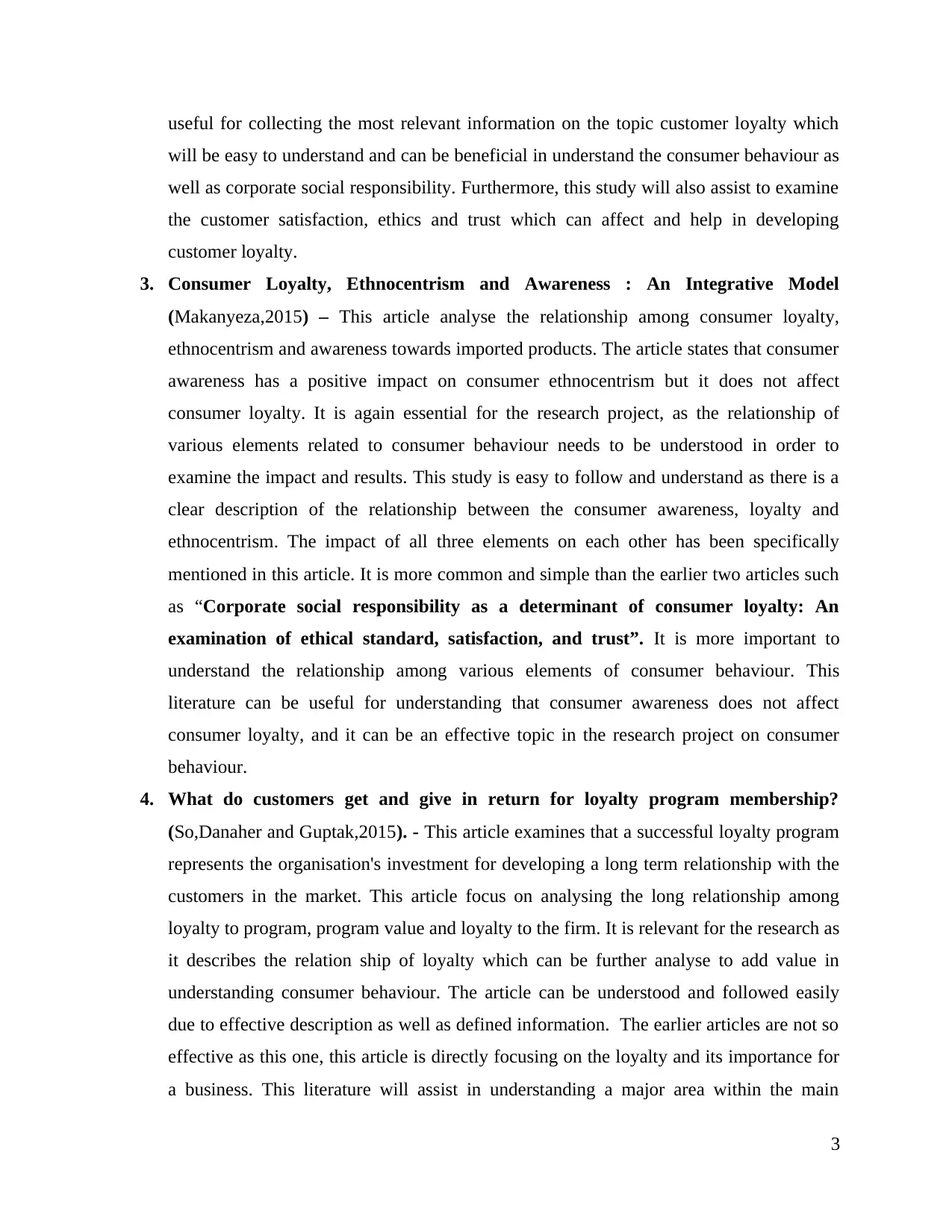
useful for collecting the most relevant information on the topic customer loyalty which
will be easy to understand and can be beneficial in understand the consumer behaviour as
well as corporate social responsibility. Furthermore, this study will also assist to examine
the customer satisfaction, ethics and trust which can affect and help in developing
customer loyalty.
3. Consumer Loyalty, Ethnocentrism and Awareness : An Integrative Model
(Makanyeza,2015) – This article analyse the relationship among consumer loyalty,
ethnocentrism and awareness towards imported products. The article states that consumer
awareness has a positive impact on consumer ethnocentrism but it does not affect
consumer loyalty. It is again essential for the research project, as the relationship of
various elements related to consumer behaviour needs to be understood in order to
examine the impact and results. This study is easy to follow and understand as there is a
clear description of the relationship between the consumer awareness, loyalty and
ethnocentrism. The impact of all three elements on each other has been specifically
mentioned in this article. It is more common and simple than the earlier two articles such
as “Corporate social responsibility as a determinant of consumer loyalty: An
examination of ethical standard, satisfaction, and trust”. It is more important to
understand the relationship among various elements of consumer behaviour. This
literature can be useful for understanding that consumer awareness does not affect
consumer loyalty, and it can be an effective topic in the research project on consumer
behaviour.
4. What do customers get and give in return for loyalty program membership?
(So,Danaher and Guptak,2015). - This article examines that a successful loyalty program
represents the organisation's investment for developing a long term relationship with the
customers in the market. This article focus on analysing the long relationship among
loyalty to program, program value and loyalty to the firm. It is relevant for the research as
it describes the relation ship of loyalty which can be further analyse to add value in
understanding consumer behaviour. The article can be understood and followed easily
due to effective description as well as defined information. The earlier articles are not so
effective as this one, this article is directly focusing on the loyalty and its importance for
a business. This literature will assist in understanding a major area within the main
3
will be easy to understand and can be beneficial in understand the consumer behaviour as
well as corporate social responsibility. Furthermore, this study will also assist to examine
the customer satisfaction, ethics and trust which can affect and help in developing
customer loyalty.
3. Consumer Loyalty, Ethnocentrism and Awareness : An Integrative Model
(Makanyeza,2015) – This article analyse the relationship among consumer loyalty,
ethnocentrism and awareness towards imported products. The article states that consumer
awareness has a positive impact on consumer ethnocentrism but it does not affect
consumer loyalty. It is again essential for the research project, as the relationship of
various elements related to consumer behaviour needs to be understood in order to
examine the impact and results. This study is easy to follow and understand as there is a
clear description of the relationship between the consumer awareness, loyalty and
ethnocentrism. The impact of all three elements on each other has been specifically
mentioned in this article. It is more common and simple than the earlier two articles such
as “Corporate social responsibility as a determinant of consumer loyalty: An
examination of ethical standard, satisfaction, and trust”. It is more important to
understand the relationship among various elements of consumer behaviour. This
literature can be useful for understanding that consumer awareness does not affect
consumer loyalty, and it can be an effective topic in the research project on consumer
behaviour.
4. What do customers get and give in return for loyalty program membership?
(So,Danaher and Guptak,2015). - This article examines that a successful loyalty program
represents the organisation's investment for developing a long term relationship with the
customers in the market. This article focus on analysing the long relationship among
loyalty to program, program value and loyalty to the firm. It is relevant for the research as
it describes the relation ship of loyalty which can be further analyse to add value in
understanding consumer behaviour. The article can be understood and followed easily
due to effective description as well as defined information. The earlier articles are not so
effective as this one, this article is directly focusing on the loyalty and its importance for
a business. This literature will assist in understanding a major area within the main
3
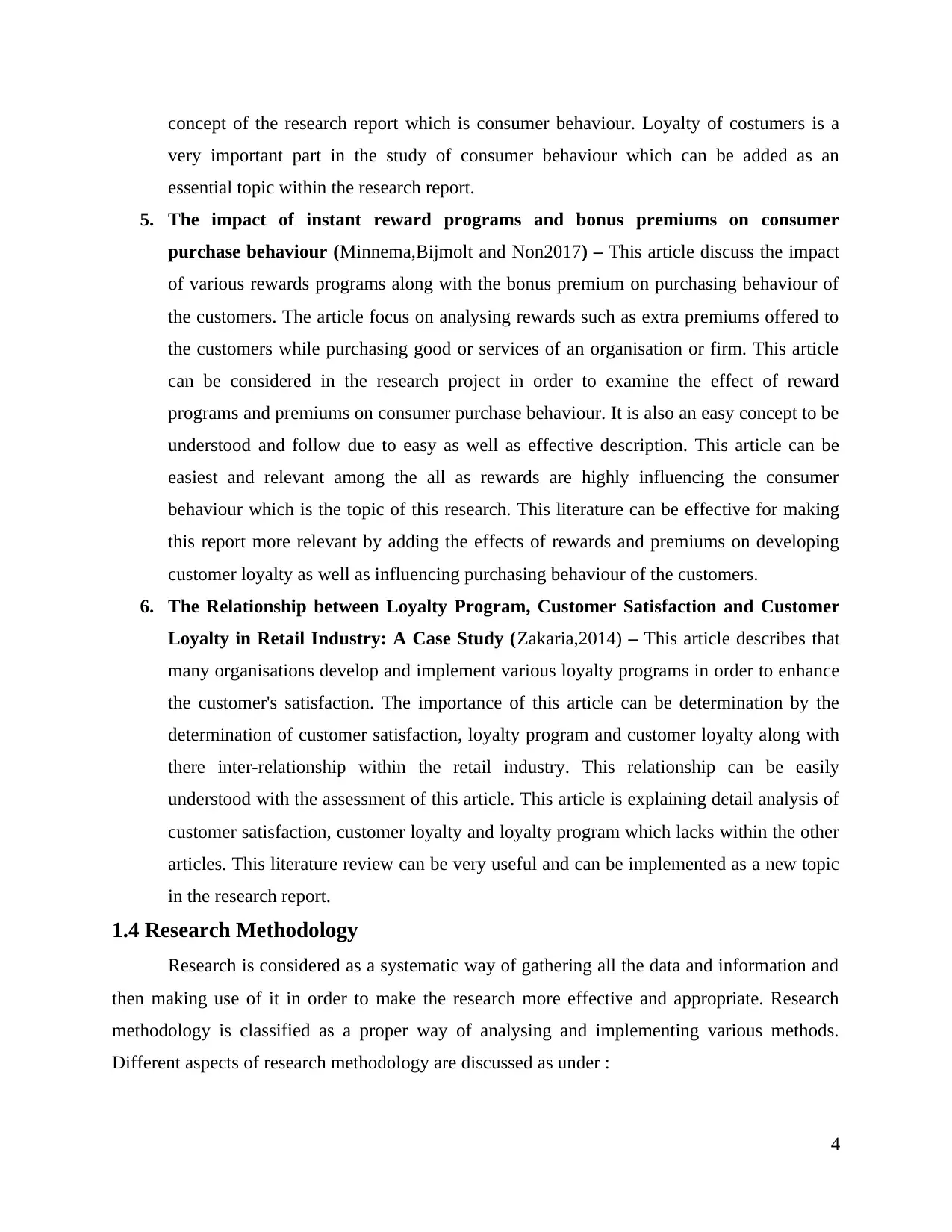
concept of the research report which is consumer behaviour. Loyalty of costumers is a
very important part in the study of consumer behaviour which can be added as an
essential topic within the research report.
5. The impact of instant reward programs and bonus premiums on consumer
purchase behaviour (Minnema,Bijmolt and Non2017) – This article discuss the impact
of various rewards programs along with the bonus premium on purchasing behaviour of
the customers. The article focus on analysing rewards such as extra premiums offered to
the customers while purchasing good or services of an organisation or firm. This article
can be considered in the research project in order to examine the effect of reward
programs and premiums on consumer purchase behaviour. It is also an easy concept to be
understood and follow due to easy as well as effective description. This article can be
easiest and relevant among the all as rewards are highly influencing the consumer
behaviour which is the topic of this research. This literature can be effective for making
this report more relevant by adding the effects of rewards and premiums on developing
customer loyalty as well as influencing purchasing behaviour of the customers.
6. The Relationship between Loyalty Program, Customer Satisfaction and Customer
Loyalty in Retail Industry: A Case Study (Zakaria,2014) – This article describes that
many organisations develop and implement various loyalty programs in order to enhance
the customer's satisfaction. The importance of this article can be determination by the
determination of customer satisfaction, loyalty program and customer loyalty along with
there inter-relationship within the retail industry. This relationship can be easily
understood with the assessment of this article. This article is explaining detail analysis of
customer satisfaction, customer loyalty and loyalty program which lacks within the other
articles. This literature review can be very useful and can be implemented as a new topic
in the research report.
1.4 Research Methodology
Research is considered as a systematic way of gathering all the data and information and
then making use of it in order to make the research more effective and appropriate. Research
methodology is classified as a proper way of analysing and implementing various methods.
Different aspects of research methodology are discussed as under :
4
very important part in the study of consumer behaviour which can be added as an
essential topic within the research report.
5. The impact of instant reward programs and bonus premiums on consumer
purchase behaviour (Minnema,Bijmolt and Non2017) – This article discuss the impact
of various rewards programs along with the bonus premium on purchasing behaviour of
the customers. The article focus on analysing rewards such as extra premiums offered to
the customers while purchasing good or services of an organisation or firm. This article
can be considered in the research project in order to examine the effect of reward
programs and premiums on consumer purchase behaviour. It is also an easy concept to be
understood and follow due to easy as well as effective description. This article can be
easiest and relevant among the all as rewards are highly influencing the consumer
behaviour which is the topic of this research. This literature can be effective for making
this report more relevant by adding the effects of rewards and premiums on developing
customer loyalty as well as influencing purchasing behaviour of the customers.
6. The Relationship between Loyalty Program, Customer Satisfaction and Customer
Loyalty in Retail Industry: A Case Study (Zakaria,2014) – This article describes that
many organisations develop and implement various loyalty programs in order to enhance
the customer's satisfaction. The importance of this article can be determination by the
determination of customer satisfaction, loyalty program and customer loyalty along with
there inter-relationship within the retail industry. This relationship can be easily
understood with the assessment of this article. This article is explaining detail analysis of
customer satisfaction, customer loyalty and loyalty program which lacks within the other
articles. This literature review can be very useful and can be implemented as a new topic
in the research report.
1.4 Research Methodology
Research is considered as a systematic way of gathering all the data and information and
then making use of it in order to make the research more effective and appropriate. Research
methodology is classified as a proper way of analysing and implementing various methods.
Different aspects of research methodology are discussed as under :
4
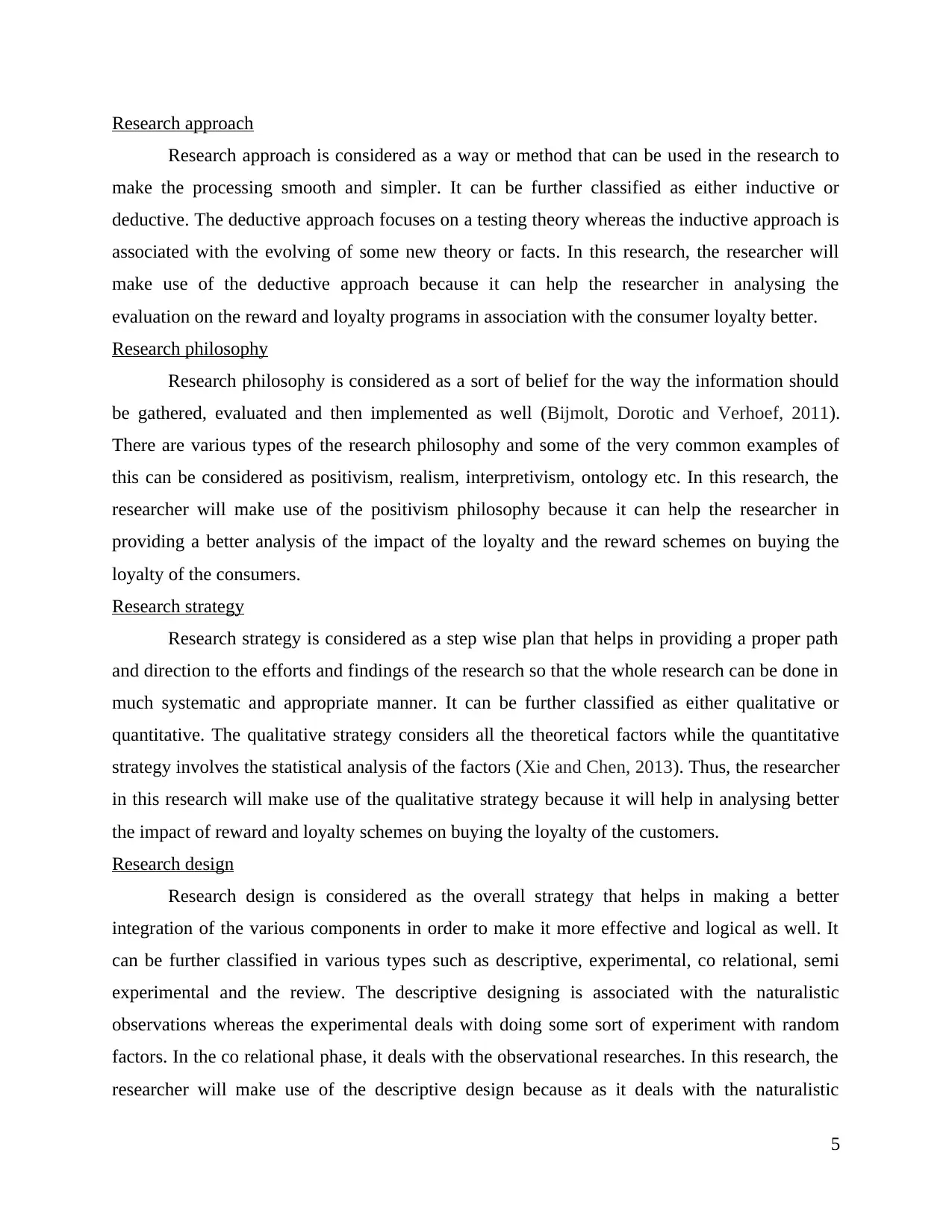
Research approach
Research approach is considered as a way or method that can be used in the research to
make the processing smooth and simpler. It can be further classified as either inductive or
deductive. The deductive approach focuses on a testing theory whereas the inductive approach is
associated with the evolving of some new theory or facts. In this research, the researcher will
make use of the deductive approach because it can help the researcher in analysing the
evaluation on the reward and loyalty programs in association with the consumer loyalty better.
Research philosophy
Research philosophy is considered as a sort of belief for the way the information should
be gathered, evaluated and then implemented as well (Bijmolt, Dorotic and Verhoef, 2011).
There are various types of the research philosophy and some of the very common examples of
this can be considered as positivism, realism, interpretivism, ontology etc. In this research, the
researcher will make use of the positivism philosophy because it can help the researcher in
providing a better analysis of the impact of the loyalty and the reward schemes on buying the
loyalty of the consumers.
Research strategy
Research strategy is considered as a step wise plan that helps in providing a proper path
and direction to the efforts and findings of the research so that the whole research can be done in
much systematic and appropriate manner. It can be further classified as either qualitative or
quantitative. The qualitative strategy considers all the theoretical factors while the quantitative
strategy involves the statistical analysis of the factors (Xie and Chen, 2013). Thus, the researcher
in this research will make use of the qualitative strategy because it will help in analysing better
the impact of reward and loyalty schemes on buying the loyalty of the customers.
Research design
Research design is considered as the overall strategy that helps in making a better
integration of the various components in order to make it more effective and logical as well. It
can be further classified in various types such as descriptive, experimental, co relational, semi
experimental and the review. The descriptive designing is associated with the naturalistic
observations whereas the experimental deals with doing some sort of experiment with random
factors. In the co relational phase, it deals with the observational researches. In this research, the
researcher will make use of the descriptive design because as it deals with the naturalistic
5
Research approach is considered as a way or method that can be used in the research to
make the processing smooth and simpler. It can be further classified as either inductive or
deductive. The deductive approach focuses on a testing theory whereas the inductive approach is
associated with the evolving of some new theory or facts. In this research, the researcher will
make use of the deductive approach because it can help the researcher in analysing the
evaluation on the reward and loyalty programs in association with the consumer loyalty better.
Research philosophy
Research philosophy is considered as a sort of belief for the way the information should
be gathered, evaluated and then implemented as well (Bijmolt, Dorotic and Verhoef, 2011).
There are various types of the research philosophy and some of the very common examples of
this can be considered as positivism, realism, interpretivism, ontology etc. In this research, the
researcher will make use of the positivism philosophy because it can help the researcher in
providing a better analysis of the impact of the loyalty and the reward schemes on buying the
loyalty of the consumers.
Research strategy
Research strategy is considered as a step wise plan that helps in providing a proper path
and direction to the efforts and findings of the research so that the whole research can be done in
much systematic and appropriate manner. It can be further classified as either qualitative or
quantitative. The qualitative strategy considers all the theoretical factors while the quantitative
strategy involves the statistical analysis of the factors (Xie and Chen, 2013). Thus, the researcher
in this research will make use of the qualitative strategy because it will help in analysing better
the impact of reward and loyalty schemes on buying the loyalty of the customers.
Research design
Research design is considered as the overall strategy that helps in making a better
integration of the various components in order to make it more effective and logical as well. It
can be further classified in various types such as descriptive, experimental, co relational, semi
experimental and the review. The descriptive designing is associated with the naturalistic
observations whereas the experimental deals with doing some sort of experiment with random
factors. In the co relational phase, it deals with the observational researches. In this research, the
researcher will make use of the descriptive design because as it deals with the naturalistic
5
Paraphrase This Document
Need a fresh take? Get an instant paraphrase of this document with our AI Paraphraser
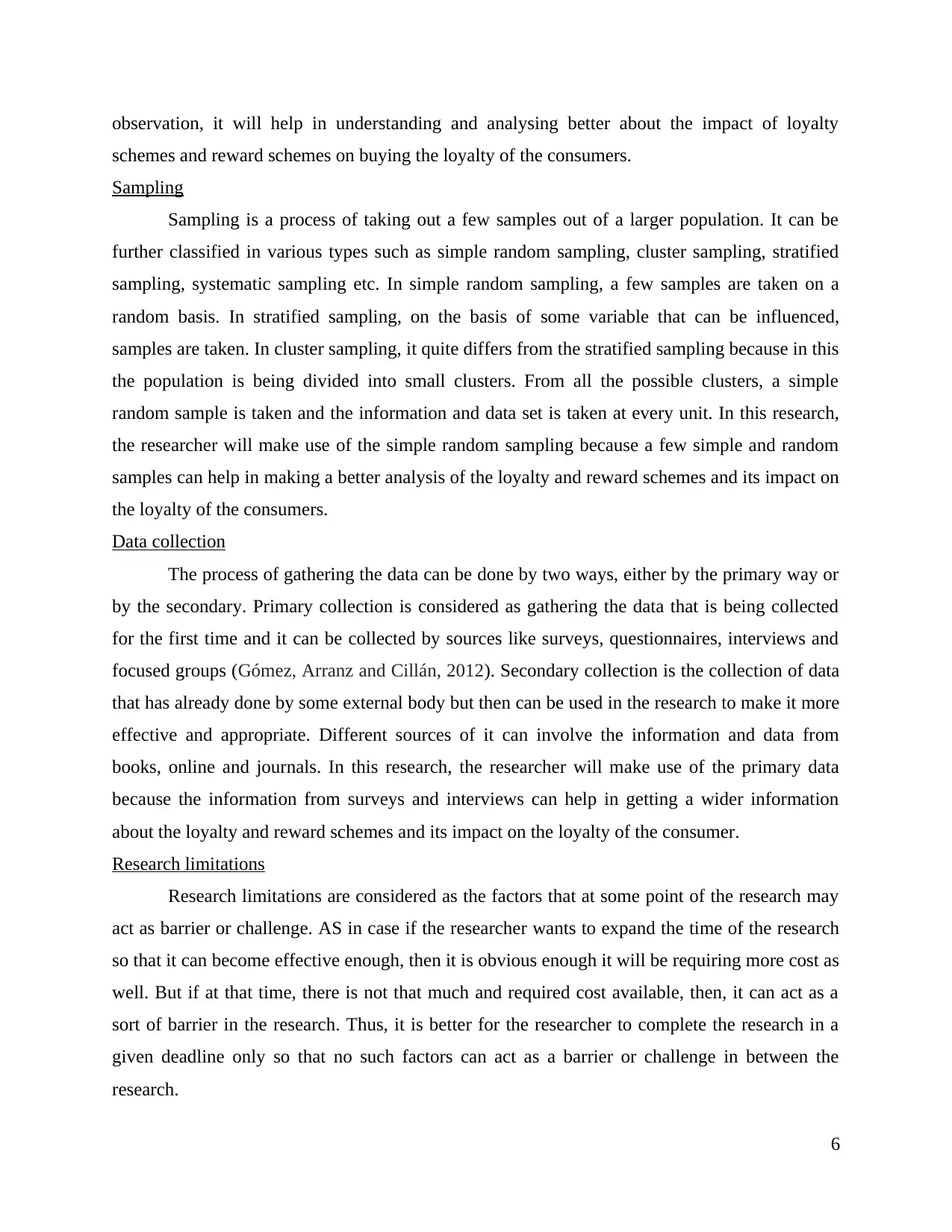
observation, it will help in understanding and analysing better about the impact of loyalty
schemes and reward schemes on buying the loyalty of the consumers.
Sampling
Sampling is a process of taking out a few samples out of a larger population. It can be
further classified in various types such as simple random sampling, cluster sampling, stratified
sampling, systematic sampling etc. In simple random sampling, a few samples are taken on a
random basis. In stratified sampling, on the basis of some variable that can be influenced,
samples are taken. In cluster sampling, it quite differs from the stratified sampling because in this
the population is being divided into small clusters. From all the possible clusters, a simple
random sample is taken and the information and data set is taken at every unit. In this research,
the researcher will make use of the simple random sampling because a few simple and random
samples can help in making a better analysis of the loyalty and reward schemes and its impact on
the loyalty of the consumers.
Data collection
The process of gathering the data can be done by two ways, either by the primary way or
by the secondary. Primary collection is considered as gathering the data that is being collected
for the first time and it can be collected by sources like surveys, questionnaires, interviews and
focused groups (Gómez, Arranz and Cillán, 2012). Secondary collection is the collection of data
that has already done by some external body but then can be used in the research to make it more
effective and appropriate. Different sources of it can involve the information and data from
books, online and journals. In this research, the researcher will make use of the primary data
because the information from surveys and interviews can help in getting a wider information
about the loyalty and reward schemes and its impact on the loyalty of the consumer.
Research limitations
Research limitations are considered as the factors that at some point of the research may
act as barrier or challenge. AS in case if the researcher wants to expand the time of the research
so that it can become effective enough, then it is obvious enough it will be requiring more cost as
well. But if at that time, there is not that much and required cost available, then, it can act as a
sort of barrier in the research. Thus, it is better for the researcher to complete the research in a
given deadline only so that no such factors can act as a barrier or challenge in between the
research.
6
schemes and reward schemes on buying the loyalty of the consumers.
Sampling
Sampling is a process of taking out a few samples out of a larger population. It can be
further classified in various types such as simple random sampling, cluster sampling, stratified
sampling, systematic sampling etc. In simple random sampling, a few samples are taken on a
random basis. In stratified sampling, on the basis of some variable that can be influenced,
samples are taken. In cluster sampling, it quite differs from the stratified sampling because in this
the population is being divided into small clusters. From all the possible clusters, a simple
random sample is taken and the information and data set is taken at every unit. In this research,
the researcher will make use of the simple random sampling because a few simple and random
samples can help in making a better analysis of the loyalty and reward schemes and its impact on
the loyalty of the consumers.
Data collection
The process of gathering the data can be done by two ways, either by the primary way or
by the secondary. Primary collection is considered as gathering the data that is being collected
for the first time and it can be collected by sources like surveys, questionnaires, interviews and
focused groups (Gómez, Arranz and Cillán, 2012). Secondary collection is the collection of data
that has already done by some external body but then can be used in the research to make it more
effective and appropriate. Different sources of it can involve the information and data from
books, online and journals. In this research, the researcher will make use of the primary data
because the information from surveys and interviews can help in getting a wider information
about the loyalty and reward schemes and its impact on the loyalty of the consumer.
Research limitations
Research limitations are considered as the factors that at some point of the research may
act as barrier or challenge. AS in case if the researcher wants to expand the time of the research
so that it can become effective enough, then it is obvious enough it will be requiring more cost as
well. But if at that time, there is not that much and required cost available, then, it can act as a
sort of barrier in the research. Thus, it is better for the researcher to complete the research in a
given deadline only so that no such factors can act as a barrier or challenge in between the
research.
6
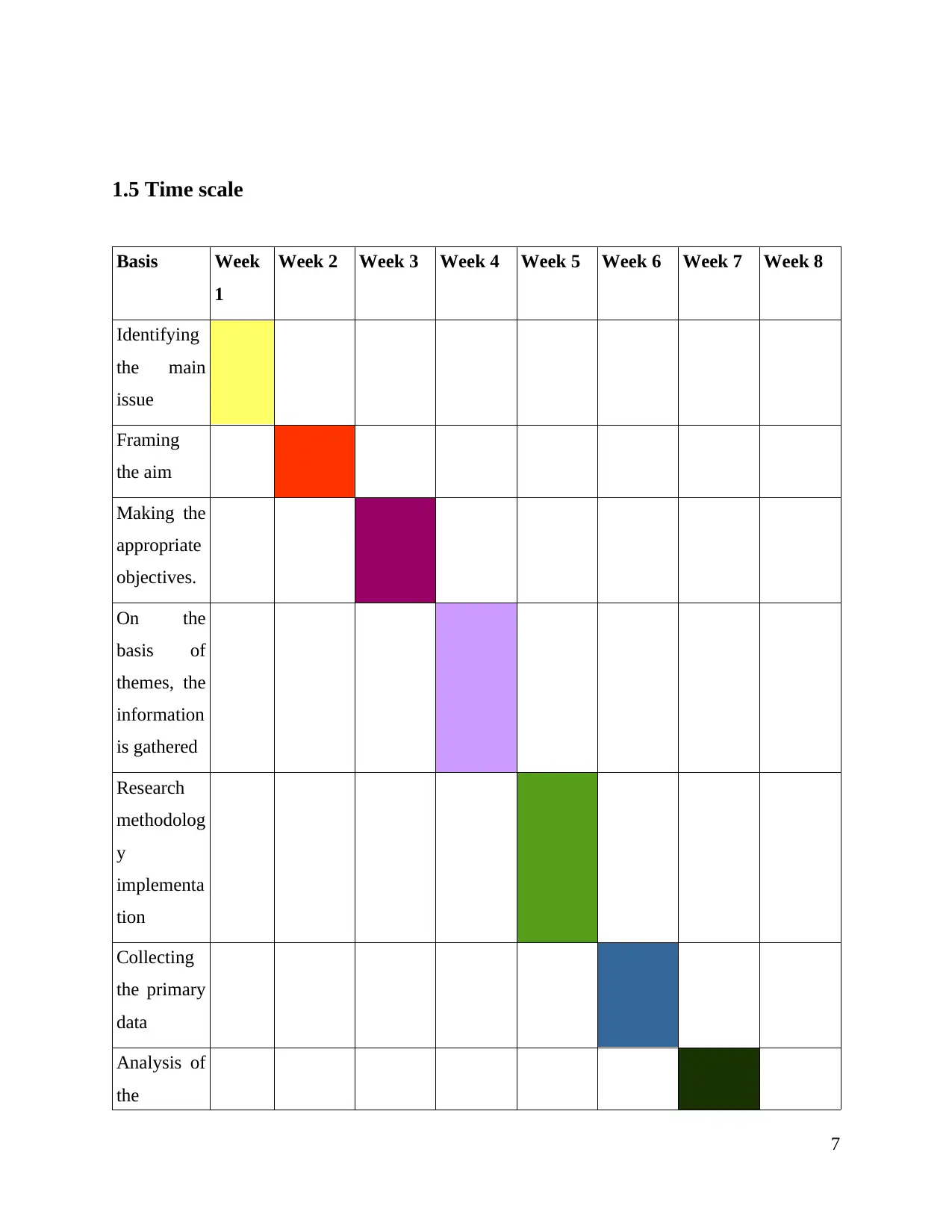
1.5 Time scale
Basis Week
1
Week 2 Week 3 Week 4 Week 5 Week 6 Week 7 Week 8
Identifying
the main
issue
Framing
the aim
Making the
appropriate
objectives.
On the
basis of
themes, the
information
is gathered
Research
methodolog
y
implementa
tion
Collecting
the primary
data
Analysis of
the
7
Basis Week
1
Week 2 Week 3 Week 4 Week 5 Week 6 Week 7 Week 8
Identifying
the main
issue
Framing
the aim
Making the
appropriate
objectives.
On the
basis of
themes, the
information
is gathered
Research
methodolog
y
implementa
tion
Collecting
the primary
data
Analysis of
the
7
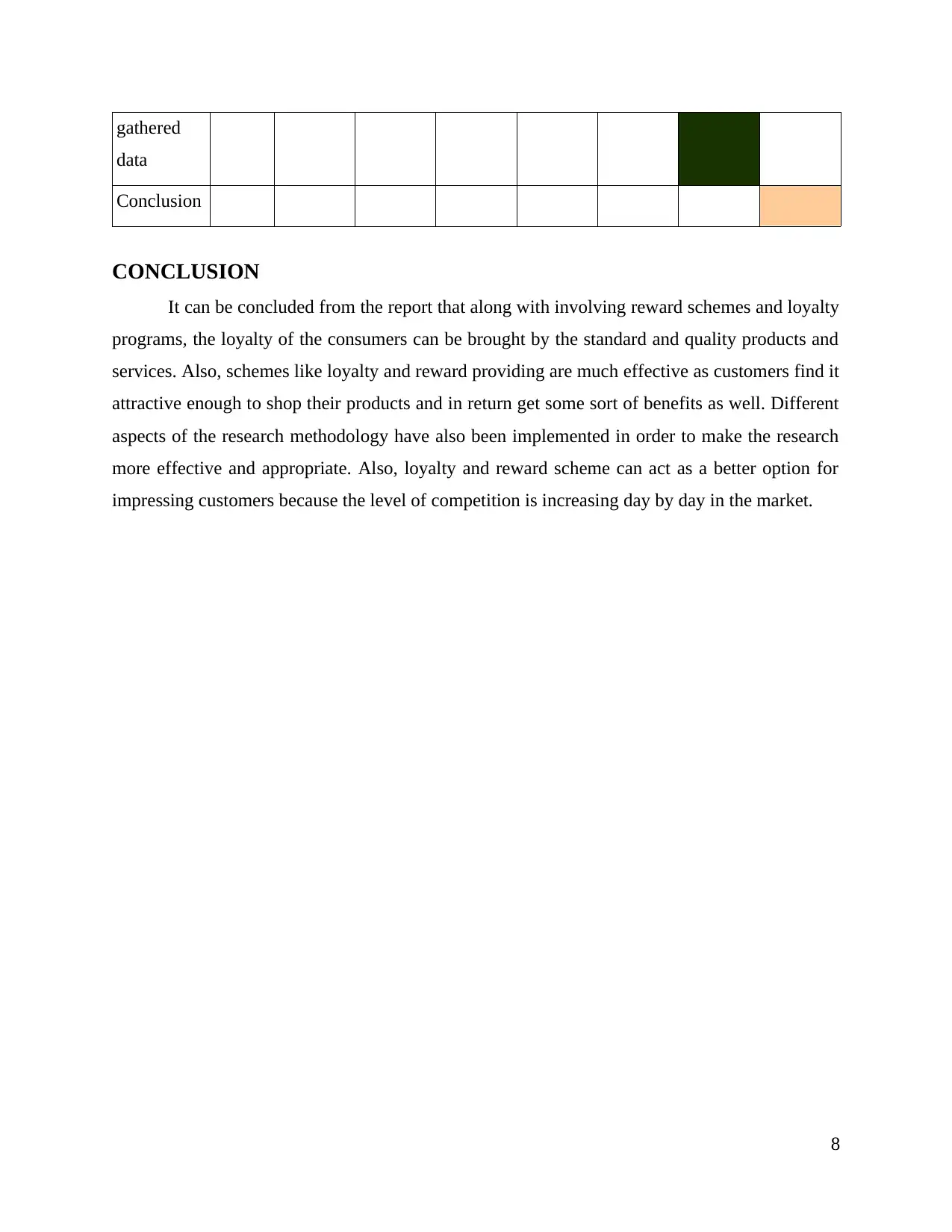
gathered
data
Conclusion
CONCLUSION
It can be concluded from the report that along with involving reward schemes and loyalty
programs, the loyalty of the consumers can be brought by the standard and quality products and
services. Also, schemes like loyalty and reward providing are much effective as customers find it
attractive enough to shop their products and in return get some sort of benefits as well. Different
aspects of the research methodology have also been implemented in order to make the research
more effective and appropriate. Also, loyalty and reward scheme can act as a better option for
impressing customers because the level of competition is increasing day by day in the market.
8
data
Conclusion
CONCLUSION
It can be concluded from the report that along with involving reward schemes and loyalty
programs, the loyalty of the consumers can be brought by the standard and quality products and
services. Also, schemes like loyalty and reward providing are much effective as customers find it
attractive enough to shop their products and in return get some sort of benefits as well. Different
aspects of the research methodology have also been implemented in order to make the research
more effective and appropriate. Also, loyalty and reward scheme can act as a better option for
impressing customers because the level of competition is increasing day by day in the market.
8
Secure Best Marks with AI Grader
Need help grading? Try our AI Grader for instant feedback on your assignments.
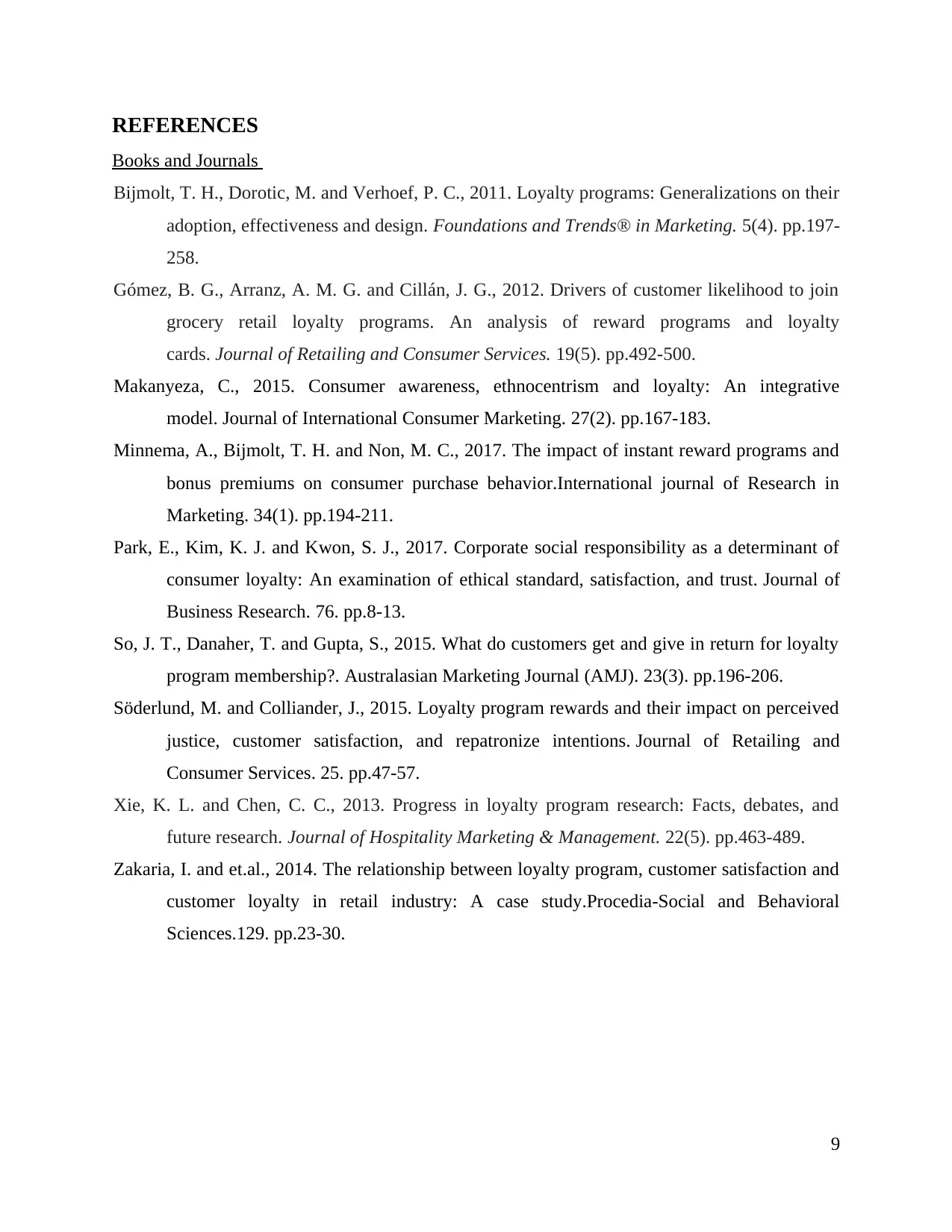
REFERENCES
Books and Journals
Bijmolt, T. H., Dorotic, M. and Verhoef, P. C., 2011. Loyalty programs: Generalizations on their
adoption, effectiveness and design. Foundations and Trends® in Marketing. 5(4). pp.197-
258.
Gómez, B. G., Arranz, A. M. G. and Cillán, J. G., 2012. Drivers of customer likelihood to join
grocery retail loyalty programs. An analysis of reward programs and loyalty
cards. Journal of Retailing and Consumer Services. 19(5). pp.492-500.
Makanyeza, C., 2015. Consumer awareness, ethnocentrism and loyalty: An integrative
model. Journal of International Consumer Marketing. 27(2). pp.167-183.
Minnema, A., Bijmolt, T. H. and Non, M. C., 2017. The impact of instant reward programs and
bonus premiums on consumer purchase behavior.International journal of Research in
Marketing. 34(1). pp.194-211.
Park, E., Kim, K. J. and Kwon, S. J., 2017. Corporate social responsibility as a determinant of
consumer loyalty: An examination of ethical standard, satisfaction, and trust. Journal of
Business Research. 76. pp.8-13.
So, J. T., Danaher, T. and Gupta, S., 2015. What do customers get and give in return for loyalty
program membership?. Australasian Marketing Journal (AMJ). 23(3). pp.196-206.
Söderlund, M. and Colliander, J., 2015. Loyalty program rewards and their impact on perceived
justice, customer satisfaction, and repatronize intentions. Journal of Retailing and
Consumer Services. 25. pp.47-57.
Xie, K. L. and Chen, C. C., 2013. Progress in loyalty program research: Facts, debates, and
future research. Journal of Hospitality Marketing & Management. 22(5). pp.463-489.
Zakaria, I. and et.al., 2014. The relationship between loyalty program, customer satisfaction and
customer loyalty in retail industry: A case study.Procedia-Social and Behavioral
Sciences.129. pp.23-30.
9
Books and Journals
Bijmolt, T. H., Dorotic, M. and Verhoef, P. C., 2011. Loyalty programs: Generalizations on their
adoption, effectiveness and design. Foundations and Trends® in Marketing. 5(4). pp.197-
258.
Gómez, B. G., Arranz, A. M. G. and Cillán, J. G., 2012. Drivers of customer likelihood to join
grocery retail loyalty programs. An analysis of reward programs and loyalty
cards. Journal of Retailing and Consumer Services. 19(5). pp.492-500.
Makanyeza, C., 2015. Consumer awareness, ethnocentrism and loyalty: An integrative
model. Journal of International Consumer Marketing. 27(2). pp.167-183.
Minnema, A., Bijmolt, T. H. and Non, M. C., 2017. The impact of instant reward programs and
bonus premiums on consumer purchase behavior.International journal of Research in
Marketing. 34(1). pp.194-211.
Park, E., Kim, K. J. and Kwon, S. J., 2017. Corporate social responsibility as a determinant of
consumer loyalty: An examination of ethical standard, satisfaction, and trust. Journal of
Business Research. 76. pp.8-13.
So, J. T., Danaher, T. and Gupta, S., 2015. What do customers get and give in return for loyalty
program membership?. Australasian Marketing Journal (AMJ). 23(3). pp.196-206.
Söderlund, M. and Colliander, J., 2015. Loyalty program rewards and their impact on perceived
justice, customer satisfaction, and repatronize intentions. Journal of Retailing and
Consumer Services. 25. pp.47-57.
Xie, K. L. and Chen, C. C., 2013. Progress in loyalty program research: Facts, debates, and
future research. Journal of Hospitality Marketing & Management. 22(5). pp.463-489.
Zakaria, I. and et.al., 2014. The relationship between loyalty program, customer satisfaction and
customer loyalty in retail industry: A case study.Procedia-Social and Behavioral
Sciences.129. pp.23-30.
9
1 out of 11
Your All-in-One AI-Powered Toolkit for Academic Success.
+13062052269
info@desklib.com
Available 24*7 on WhatsApp / Email
![[object Object]](/_next/static/media/star-bottom.7253800d.svg)
Unlock your academic potential
© 2024 | Zucol Services PVT LTD | All rights reserved.





